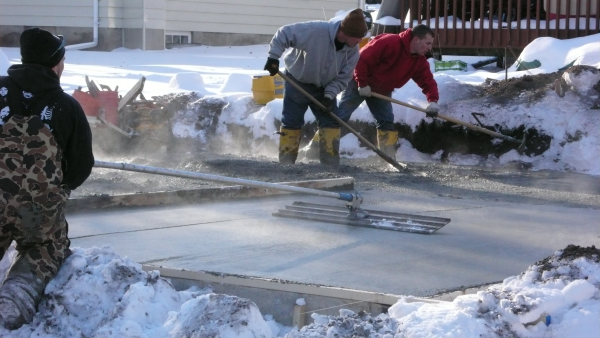BLOG
Concreting in Ottawa: Cold Weather Solutions
by TRP Ready Mix on June 19, 2016

Winter makes concreting in Ottawa more difficult than in warmer months. However, since Ottawa winters are long, successful concrete contractors know what precautions to take on winter concrete jobs in Ottawa. This knowledge is also helpful to homeowners and businesses who hire concrete contractors. Properly prepared, poured and protected, concrete projects in Ottawa in the cold hold up well to wear and tear and bad weather. Here’s how.
When the temperature drops below 5 C or will fall below that temperature within 24 hours after concrete contractors pour concrete, they must work in a different manner than they do in warmer weather. If water in the concrete freeze and thaws several times before the concrete sets or cures, it’s likely that the concrete will never be as strong or as weather-resistant as it could be. Cold temperatures slow the cure time and, therefore, the speed at which the concrete strengthens.
One way for concrete contractors to protect concrete from damage by freezing is to use air-entrained concrete. This is concrete that has lots of tiny air pockets to allow water to expand in case it freezes. To make air-entrained concrete for concrete jobs in Ottawa, contractors may add (air-entrained) portland cement, which is an ingredient in concrete, to the mixture. Or, they may add substances to the concrete that transform it into air-entrained concrete as the concrete is being mixed on the job.
Other ways to handle concrete in the cold include keeping it indoors to keep it warm before mixing it and using warm water when mixing it. Any objects that will be set in the concrete should be at least 5 C, as should any steel that reinforces it. After pouring the concrete, workers on concrete jobs in Ottawa should protect it from freezing during the curing period. During this time the temperature must never drop below 10 C. Workers can use blankets, insulated forms or heaters for this.
On concrete jobs in Ottawa, care must be taken not to let the surface of the concrete dry more quickly than the lower layers. Using heaters to dry the surface increases this risk of uneven curing, which may cause the concrete to shrink and crack. After the concrete cures, clients should not use ice melters that first winter. Instead, they should find an alternative product that promotes traction on the ice.
